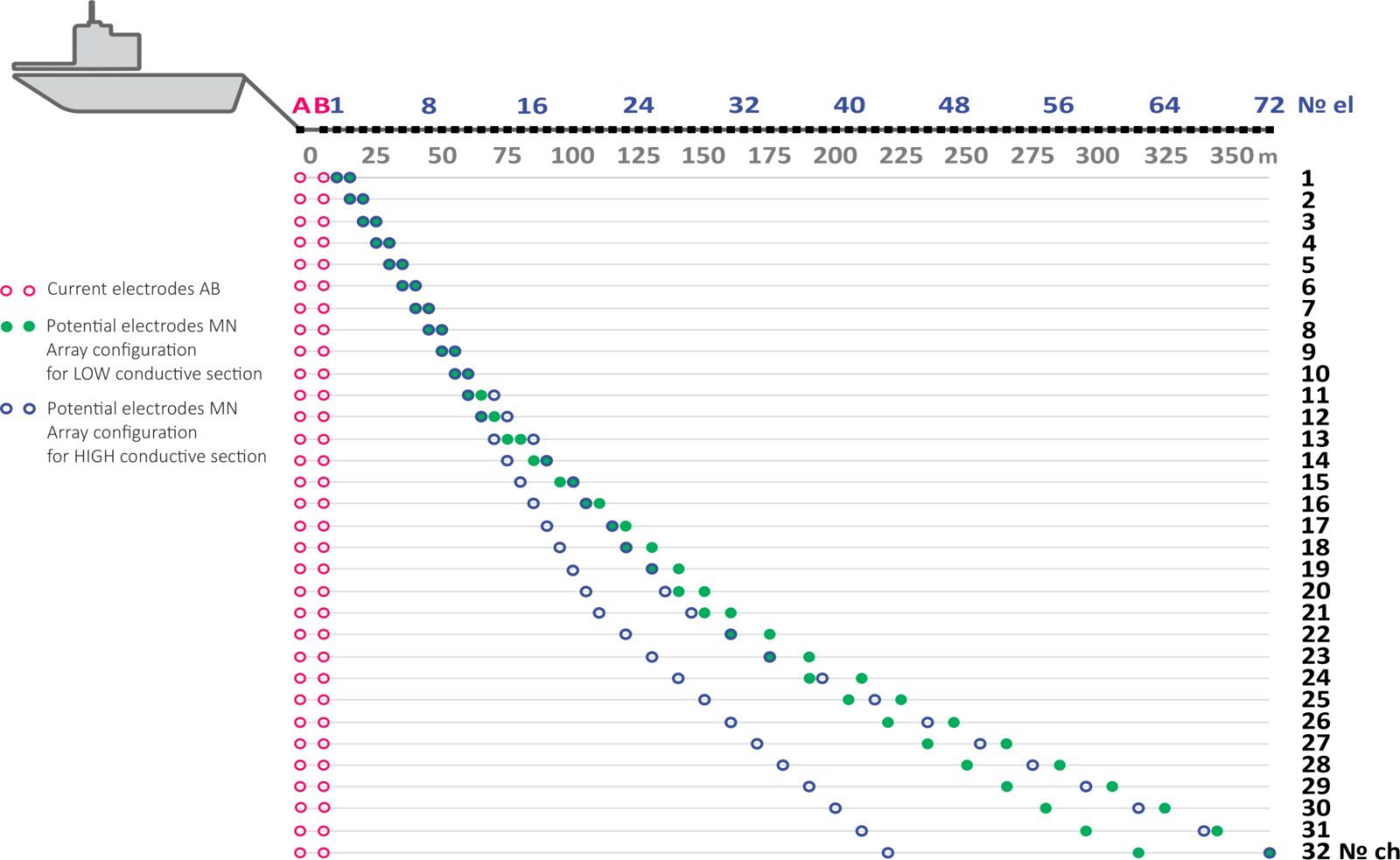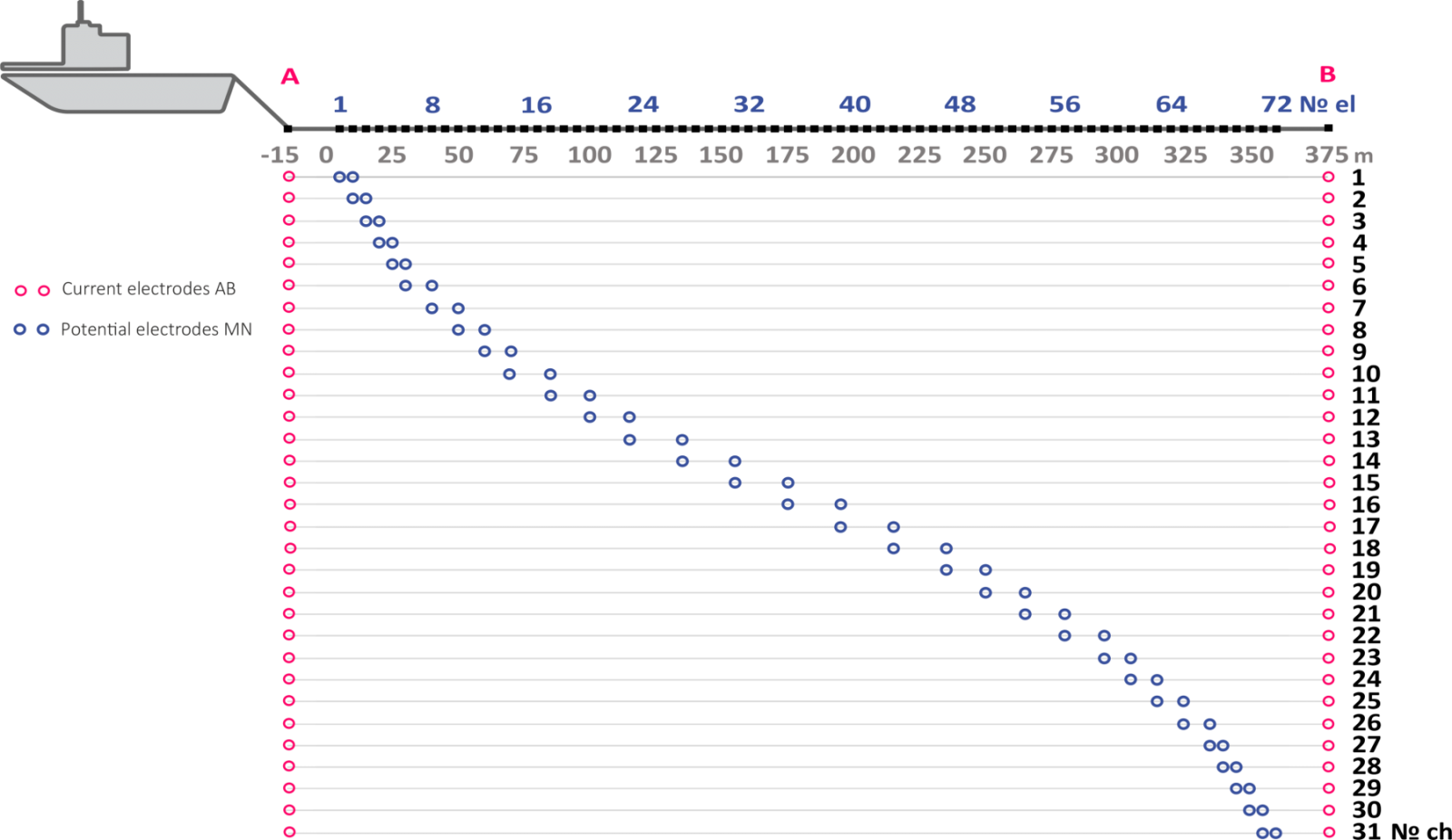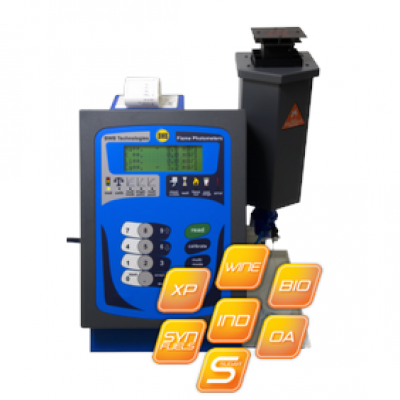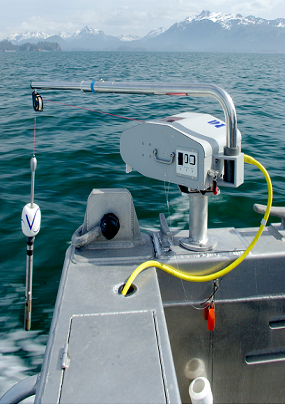ALMAZ Marine is the most modern system in the World for performing continuous aquatic sounding on DC or recording EM processes with 72-electrode towing array. A unique 3 kW generator allows using current up to 10 A, and when using an external DC source, 50 A current switching is available (optional). The built-in switchbox is designed to select one of three available array types. This approach, together with synchronous data recording on 32 channels, provides the highest possible resolution and depth of study achieveble with electrical tomography method - up to ~100-150 m (array with 5 m electrode spacing) both in fresh and marine water with a bottom depth of up to a few tens of meters.
Receivers
ALMAZ Marine has 32 precision channels with constant self-potential (SP) compensation. Another two channels are reserved for recording of current and signal voltage measurement. All that raw data can be recorded with sampling rate up to 3,600 Hz (7,200 Hz on request) per channel for further processing. Each receiver is isolated and has a filter. ALMAZ receiver is among the best on the market and provides minimal noise and good phase characteristics stability.
Transmitter
We have developed a 3 000 W power transmitter designed for aquatic applications. It works with currents up to 10 A and voltages up to 300 V (up to 600 V peak-to-peak) using a meander or paused meander waveform. These parameters provide measurable signal on all channels with standard 5-meter electrode spacing streamers, even in the marine area. ALMAZ Marine can also work with an external transmitter with continuous current recording in the line.
Arrays and streamers
ALMAZ Marine supports two dipole-dipole and one gradient array. The first type is intended to get the best resolution and depth in freshwater areas or high resistivity water. Gradient array provides a significantly higher signal level at the receiver dipoles, so it is preferable in salty or heavily polluted (with resistivity starting from 0.2 Ohm∙m) water areas. Both arrays are designed to provide optimal data coverage of the pseudosection.
ALMAZ Marine is supplied with 72-electrode streamer. The standard spacing between the electrodes along the streamer is 2 - 5 meters. Transmitter electrodes are located outside the receiving streamer, and their spacing is easily adjustable. Thus, the length of an array varies from 146 to >365 m, which allows to estimate the depth of the survey in average geological conditions from 35 to 150 m, respectively.
Streamer for near-surface towing has floats, that allow to control immersion depth while keeping the streamer visible while towing. The floats can be detached, so that the streamer is laid on the bottom, connected to an optional switchbox, and bottom ERT observations can be performed. Deep-towed streamers with built-in pressure sensors, magnetic compasses and INS are also available, which allows to calculate array positioning precisely. Bottom towing is another option which increases the resolution and depth of surveys, while maintaining a high speed of surveying.
Delivery set:
ALMAZ Marine unit
- Software for survey planning and data collection
- Towed streamer with a set of current electrodes and floats
Optional:
- Onboard GNSS receiver
- Tail buoy with GNSS receiver
- Switchbox for bottom arrays
- Deep-towed streamer with a set of transmitter electrodes
- ALMAZ Marine unit with the sampling rate of 7 200 Hz
- ALMAZ Marine unit with 50A switchbox
- ALMAZ Marine unit for AUVs and ROVs
- ZondRes2d software
- ZondRes3d software
On request it is possible to customize ALMAZ Marine unit for a submersible version in a sealed container for installation on controlled underwater vehicles or with other additional features. In order to properly formulate technical specs of your system, please contact us in any way indicated on the website.
|
Number of channels
|
32
|
|
Number of electrodes
|
72
|
|
Electrode spacing
|
2, 2.5, 4, or 5 m
|
|
Supported arrays
|
Two dipole-dipole and one gradient
|
|
Maximum output power
|
3 000 W (power supply 220 VAC 50/60Hz)
5 000 W (up to 8 12V batteries in series or optional AC/DC converter)
|
|
Maximum output current
|
10 A (power supply 220 VAC 50/60Hz)
50 A (up to 8 12V batteries in series or optional AC/DC converter)
|
|
Maximum output voltage
|
600 Vp-p (power supply 220 VAC 50/60Hz)
200 Vp-p (up to 8 12V batteries in series or optional AC/DC converter)
|
|
Output current waveform
|
ON+/ON- or ON+/OFF/ON-/OFF
|
|
Transmitter frequency
|
0 - 72 Hz
Optional: 0 - 50 kHz
|
|
Measurement range of channels
|
Channel 1: ±20 V
Channels 2-32: ±10 V
|
|
Measurement resolution
|
100 nV, depends on voltage level
|
|
Input impedance
|
5 MOhm
|
|
Total accuracy
|
better than 1 %
|
|
Sampling rate
|
3 600 Hz
Optional: 7 200 Hz
|
|
Measured and calculated values
|
Voltage, current, apparent resistivity, percent frequency effect, chargeability, self-potential, electrode coordinates
|
|
Data transfer
|
Ethernet 1Gb
|
|
GNSS receiver (optional)
|
External with RS-232 (NMEA 0183) connection with the ability to record RAW data.
Received signals: GPS L1C/A and L2C; GLONASS L1OF and L2OF; Galileo E1B/C and E5b; BeiDou B1I and B2I; QZSS L1C/A, L1S, and L2C. SBAS: WAAS, EGNOS, MSAS, GAGAN, SDCM.
|
|
Power supply
|
220 VAC, 50/60 Hz
|
|
Operating temperature range
|
-20 ÷ +60 °C
|
|
Unit dimensions
|
625×500×297 mm
|
|
Measuring unit weight
|
24 kg
|

















